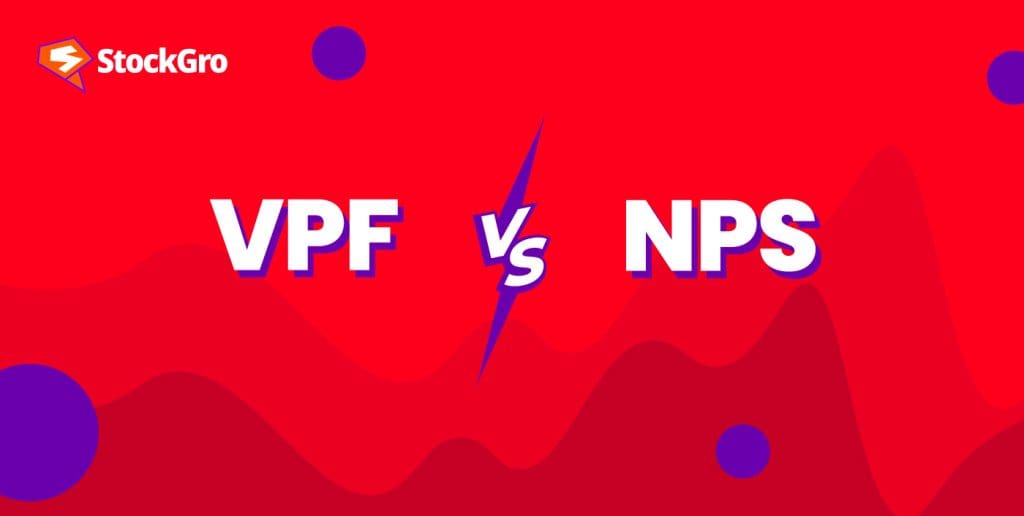
Planning for retirement is key to making sure you can enjoy your 60+ with peace. With so many options available, debates often arise comparing EPF vs PPF vs VPF vs NPS. What are they?
Each one has unique benefits, catering to different financial strategies and goals. Today, we’ll specifically focus on the clash between NPS vs VPF. Which one suits your retirement dreams better? Let’s find out.
Types of retirement schemes
Plans for your later years come in various forms, each filling to different financial needs. Understanding them can help you plan better for your future.
Employment-based pension plans: These are linked to your job, where a portion of your salary goes into the Employees Pension Scheme (EPS) with your employer also contributing, and over time this builds up, providing a monthly pension after you stop working.
Government retirement plans: The central authority offers options like the topic of our discussion NPS or National Pension Scheme. Another option is the Public Provident Fund (PPF), known for its guaranteed return and tax benefits.
Annuity plans: These plans can be immediate, starting payouts soon after you invest, or deferred, where you invest over time before receiving payments. They ensure a steady income, making them reliable for your later years.
Pension plans with life cover: Combining savings with life insurance, these plans allocate part of your money to premiums and the rest to investments. They offer financial protection for your family and a retirement income.
Choosing the right plan like VPF vs PPF vs NPS depends on your financial goals and personal circumstances. Each plan has unique features, so it’s essential to evaluate them carefully. That’s why, now let’s dive into NPS pension vs VPF.
Also read: Tax-efficient withdrawal strategies for retirement in India
What is VPF?
VPF full form Voluntary Provident Fund. It is an add-on to the Employees’ Provident Fund i.e. the EPF which lets salaried employees put in more than the standard 12% of their basic salary and dearness allowance. You can contribute any percentage of your basic pay.
VPF is considered safe because it’s backed by the government. It earns interest at the same rate as EPF, the latest rate for FY24 is 8.25%. The interest compounds annually, making your savings grow over time.
Note that the employers are not compulsorily bound to contribute to VPF, it’s solely based on the employee’s choice and once you opt in, you can’t stop or reduce contributions before five years.
It’s a tax saving scheme as well. Income tax rule u/s 80C exempts both the contributions and the interest earned. Amounts up to ₹1.5 lakh are tax-free annually.
To start, just tell your employer to increase your EPF contributions. The extra amount will be deducted from your salary and added to your VPF account. Simple and straight forward.
You may also like: The concept of EPF – All you need to know about this tax-saving fund
NPS overview
NPS is a government-initiated scheme. There is no restriction on who to contribute; if you’re in salary or in business, you’re eligible to get into the scheme. It is built on regular savings.
It comes in two types of accounts: Tier-I & Tier-II. The first is mandatory for long-term retirement savings, while the latter is optional and allows for flexible withdrawals. To start you need a minimum of ₹1,000 for Tier-I and ₹250 for the other account. No upper ceiling exists.
Managed by Pension Fund Regulatory and Development Authority or PFRDA-regulated fund managers, your NPS monthly amounts are invested in a diverse folio, including equities, government bonds, and corporate debentures. The gains are purely based on market, meaning they fluctuate based on security performance. For instance, as of June 28, 2024, Tier-I accounts have shown returns between 17-19% over five years.
Flexibility is another feature to note. You can withdraw up to a quarter of your contributions after three years for specified needs like buying property or medical emergencies. This is allowed up to three times during the account’s tenure.
Like VPF, tax exemption is available u/s 80C. But an additional ₹50k under Section 80CCD(1B).
Also read: Facts about NPS and NPS Lite
VPF vs NPS: Key differences
| Basis | VPF | NPS |
| Maturity period | Upon retirement | 60 years (extendable to 70 years) |
| Interest rate | Fixed at 8.25% p.a. | Market-linked, varies based on investment choices |
| Safety of investment | Government-backed, considered very safe | Market based, carries some risk |
| Eligibility | Only for salaried employees with EPF | Open to all Indian citizens aged 18-70 |
| Contribution | Up to 100% of basic salary and DA | Minimum ₹1000 annually for Tier-I |
| Tax benefits | Up to ₹1.5 lakh under Section 80C | ₹1.5 lakh under 80C, plus ₹50k u/s 80CCD(1B) |
| Withdrawals | Allowed under certain conditions | Partial withdrawals after 3 years for specific needs |
| Premature exit | Not allowed before 5 years of employment | Allowed after 5 years, but with conditions |
| Employer contribution | Not required | Possible, with additional tax benefits |
Bottomline
Deciding between VPF and NPS comes down to personal financial goals and risk tolerance. VPF is a safer option with a fixed interest rate, appealing to those who prioritise security.
In contrast, NPS offers market-linked returns and greater flexibility, making it attractive to individuals seeking potentially higher growth. Check your individual requirements and tastes to figure out which plan is most suited to your retirement strategy.
Make data-driven decisions with in-depth technical stock market analysis app. Master market trends with StockGro app now!FAQs
- Is NPS better than VPF?
It depends on what you need. NPS can offer higher returns since it’s linked to the market. But it’s riskier. VPF is safer with a fixed interest rate. It’s great if you want stability. Think about how much risk you’re okay with. And also, consider your long-term goals. What suits one person might not suit another. Choose what fits you best.
- Is VPF a good choice for retirement savings?
It definitely can be. It’s really safe since the government backs it. You get a fixed interest rate, which is nice. If you don’t like taking risks, VPF is a solid option. It’s also good for tax benefits. But you can’t touch the money for a while. So, if you want something stable and secure, VPF is worth considering.
- Which one is better, VPF or PPF?
It depends. VPF is for salaried employees and offers a higher interest rate. But you can’t withdraw easily. PPF is open to everyone and has a 15-year lock-in period. Both give tax benefits. Think about your job and how soon you might need the money. Each has its perks. Pick the one that fits your life best.
- Is NPS better than PPF?
It is based on your requirement. NPS has higher returns because it’s linked to the market. But it’s riskier. PPF is safer with fixed returns. It’s great if you hate risks. NPS is more flexible with how you can invest. PPF has a 15-year lock-in, which is long but stable. Think about your risk tolerance and investment goals. Both have tax benefits. Choose what suits.
- Which option is best for retirement?
It really depends on you. If you want safety, go for employment-based or government plans. They offer fixed returns and are low-risk. If you’re okay with some risk for higher returns, market-linked plans are good. They let you invest in the market. Think about how much risk you can handle. Also, consider how soon you might need the money. Invest based on your preferences.
